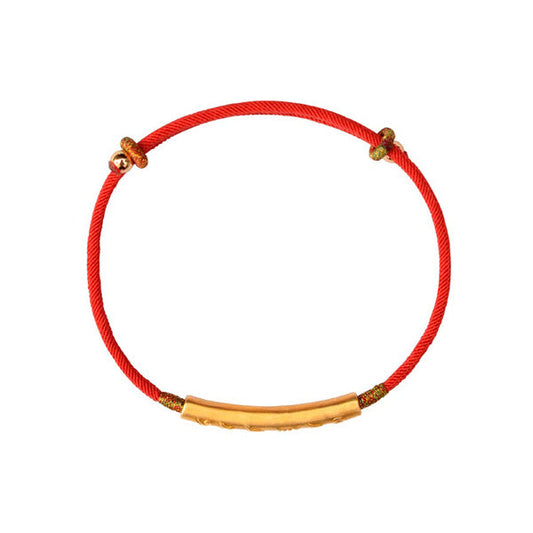Collection: Tibetan Bracelets
Scroll to the bottom of the page to discover our mini-guide on Tibetan bracelets and learn more about their history, symbolism, and benefits.
-
Tibetan Copper Bead Bracelet
Regular price 15,00 €Regular price -
Tibetan Bracelet Red Luck and Mani Mantra
Regular price 25,00 €Regular price0,00 €Sale price 25,00 € -
Tibetan lucky bracelet (6 colors)
Regular price 14,00 €Regular price -
Tibetan bracelet bodhi seed mantra
Regular price 17,00 €Regular price0,00 €Sale price 17,00 € -
Trio of Tibetan Lucky Bracelets - Style & Spirituality
Regular price 20,00 €Regular price0,00 €Sale price 20,00 € -
Silver Tree of Life Cord Bracelet – Lucky Charm Accessory
Regular price 16,00 €Regular price0,00 €Sale price 16,00 € -
Turquoise Blue Tibetan Bracelet
Regular price 21,00 €Regular price0,00 €Sale price 21,00 € -
Red Tibetan bracelet for good luck and sunshine
Regular price 15,00 €Regular price0,00 €Sale price 15,00 € -
Tibetan amazonite macrame bracelet (4mm bead)
Regular price 16,00 €Regular price0,00 €Sale price 16,00 € -
Tibetan Bracelet in Imperial Jasper Beads for Spiritual Awakening
Regular price 20,00 €Regular price0,00 €Sale price 20,00 € -
OM Bracelet in Wood and Metal
Regular price 15,00 €Regular price0,00 €Sale price 15,00 € -
Tibetan Bracelet with Grey Jasper and Tiger's Eye
Regular price 20,00 €Regular price0,00 €Sale price 20,00 € -
Multicolor Tibetan Bracelet in Jasper and Carved Metal Beads
Regular price 20,00 €Regular price0,00 €Sale price 20,00 € -
Tibetan Bracelet in Labradorite and Engraved Metal Rings
Regular price 20,00 €Regular price0,00 €Sale price 20,00 € -
Tibetan Blue Jasper Bracelet
Regular price 21,00 €Regular price0,00 €Sale price 21,00 € -
Tibetan Green Jasper Bracelet
Regular price 21,00 €Regular price0,00 €Sale price 21,00 € -
Tibetan Jasper Landscape Bracelet with Engraved Metal Rings
Regular price 20,00 €Regular price0,00 €Sale price 20,00 € -
Tibetan bracelet with bodhi seed for protection
Regular price 17,00 €Regular price0,00 €Sale price 17,00 € -
“Energy” bracelet in black tourmaline and macrame
Regular price 23,00 €Regular price0,00 €Sale price 23,00 € -
Tibetan coconut shell mantra bracelet
Regular price 19,00 €Regular price0,00 €Sale price 19,00 € -
Red or black cord couple bracelet
Regular price 17,00 €Regular price0,00 €Sale price 17,00 € -
Lucky Buddha bracelet
Regular price 15,00 €Regular price
Information about Tibetan Bracelets
Tradition of Tibetan monks
These lucky cord bracelets are available in a variety of colors and are excellent protectors against negative energy . Traditionally, the knots of these beautiful cord bracelets are tied while Tibetan Buddhists recite mantras. This charges them with positive energy and gives the bracelet a protective charm . During the weaving process, the bracelets are blessed, which is why they are often associated with good fortune. The blessing is eternal, giving the Buddhist bracelet a meaning of eternity . Many of these bracelets feature intricate patterns or designs sacred to Zen Buddhism. However, Buddhists are not the only ones who wear these cord bracelets. They are also common in Hinduism, Kabbalah, and Christianity . Worn on the left wrist, the receptive side of the body, they attract good fortune and prosperity, according to Tibetan Buddhists.
Mantras
A mantra is a specific sequence of words chanted to create a powerful vibration or sound that allows one to enter a deep, meditative state . The word mantra comes from the ancient Sanskrit language, where MAN means "mind" and TRA means "vehicle." Repeating and chanting mantras is an excellent way to focus one's mind . The vibrations of mantras are believed to have powerful spiritual and healing properties. There are many types of mantras, but the one Tibetan Buddhists recite and chant is a six-syllable prayer mantra, Om mani padme hum (Hail the jewel in the lotus), which is the essence of the Dharma. It brings blessings of protection and love and purifies all negative karma, thus bringing us closer to enlightenment .
Positive energy and colors of Tibetan bracelets
The Tibetan bracelet charges the wearer with positive energy that protects them from all the negativity in their environment . This is why it is often called a protective talisman. It transmits the essence of Zen Buddhism to its wearer, along with all its calming qualities. Wearing a cord bracelet around the wrist is a tradition that originates in Kabbalah, but is also found in Hinduism, Buddhism, and Christianity . The seven colors of Tibetan Buddhism represent the colors of the aura that surrounded the Buddha when he attained enlightenment. These colors are blue, yellow, green, red, black, white, and orange . According to Buddhist tradition, these colors are directly linked to the seven chakras of the human body . The aura is the light that surrounds our body; it can change depending on our emotional state.
The endless knot or infinite knot
The endless knot ( Buddhist knot ) is also known in Sanskrit as an eternal knot. For Buddhists, it is a symbol of the interconnectedness of all beings and events, representing the perfect harmony of the universe . The knot of eternity is one of the eight auspicious symbols of Buddhism, and it has neither beginning nor end. In Tibetan culture, the endless knot is one of the most cherished auspicious symbols, as it represents the timeless teachings of the Buddha . In Tibetan Buddhism, the Buddhist knot also represents the karmic cycle known as Samsara, which continues eternally until the soul attains liberation .
Warning
The metaphysical and healing properties described above (lithotherapy) are given for inspiration and reference, they are not scientifically proven and should be considered in the context of holistic healing and spiritual practices. We collect this information and inferred properties from writings, books, popular testimonials and various other sources. They also depend on the attitude and beliefs of the individual. Furthermore, they are not a substitute for diagnosis or treatment by a qualified therapist or physician.
feng shui wristbands
Discover our collection of Feng Shui Bracelets






















